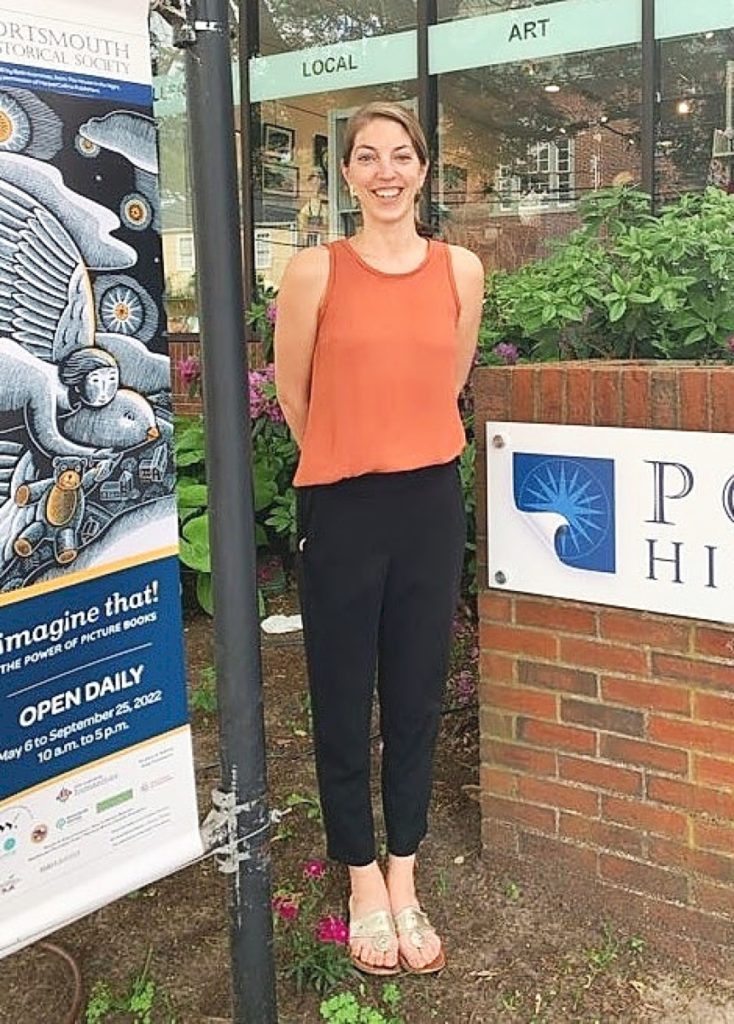
This June, Portsmouth Historical Society (PHS) announced Emma Stratton as its new executive director. Stratton has an extensive resume in history, art and house museums with a focus on American collections. She began her career at the Smithsonian American Art Museum and was most recently at the American Independence Museum in nearby Exeter. PHS includes the John Paul Jones Museum, a historic home where the Scottish naval captain John Paul Jones occupied the house only while his ship, the Ranger, was being built at the Portsmouth Naval shipyard, 1781-2. An exhibition devoted to “collectibles” bearing Jones’ name and image, “Captain, Celebrity, Cliché,” from the James and Judith Bradford collection is currently on view at the historic home until October 10. Another exhibition, “Imagine That! The Power of Picture Books,” will be displayed in PHS’s main gallery until September 25. With more than 100 illustrations on view, a calendar of events also accompanies the exhibition. Both are focused on local history and artists from the surrounding area, designed to engage patrons of all ages in the living history of the Northeast New England region. With such a wealth of material to draw from, we corresponded with Stratton about PHS’s current events and what’s in store for current and future visitors.
Congratulations on your recent appointment to executive director of the Portsmouth Historical Society. Please share a bit about your background with us.
Thank you. Prior to coming to Portsmouth Historical Society, I was the executive director for the American Independence Museum, a Revolutionary War history museum, in Exeter, N.H., for five years. Before that, I was in Washington DC where I worked for a number of museums, including the Smithsonian American Art Museum and the Heurich House Museum. Over my 15-year career in museums, I have worked in many departments, including visitor services, curatorial, registrar, marketing and public programs. I have my MA in Museum Studies from The George Washington University.
What first drew you to a career in historic preservation?
My career in historic preservation is entwined in my love of history. The storytelling aspect of history drew me to museum work and from there I developed a love of old buildings and historic preservation. One of my early formative experiences was visiting Sagamore Hill, Teddy Roosevelt’s historic home on Long Island. I loved how the stories were told and also how much the building and location influenced my visit. I believe our historic buildings tell stories, just as objects do.

The John Paul Jones Historic House Museum in Exeter, N.H.
What brought you up to New Hampshire?
I grew up on the North Shore of Massachusetts and was eager to relocate to the area to be closer to my family. I moved back to Massachusetts and within a few months started at the American Independence Museum and moved to New Hampshire. I enjoy living and working in New Hampshire; I love that the mountains and beaches are so close to where I live. Being able to spend my free time in nature makes me very happy.
One of the Portsmouth Historical Society’s current exhibitions, ‘Captain, Celebrity, Cliché; The James C. & Judith R. Bradford Collection of John Paul Jones Memorabilia,” is a continuation of Portsmouth’s adoption of Jones as a local historic figure. What has been the visitor reaction to the trove of goods showcasing one of US history’s now lesser-known Founding Fathers?
Visitors are fascinated to see the role that John Paul Jones played in the canon of the American Revolution, especially in the latter half of the Twentieth Century [when the majority of these items were produced]. It is remarkable to see how many objects from everyday life used his name and likeness to sell products. Many people (myself included) didn’t realize he was the subject of a major motion picture in 1959!
PHS’s other current exhibition, “Imagine That! The Power of Picture Books,” seems like a departure from past subjects. Is this a step in a new direction?
It is a departure for the society in a few ways. The subject matter is regional, focusing on Northern New England, whereas our past exhibitions have focused on Portsmouth and the surrounding Seacoast area. Additionally, our intended audience is families with young children. As such, the exhibition is designed with young visitors in mind; the artwork is hung lower on the walls, book rails with corresponding books are low to the ground and there are many interactive reading and play stations throughout the exhibition. The society is certainly working to expand our visibility and our audience, and in that way, we are heading in a new and more engaging direction.
What’s next for Portsmouth Historical Society?
Next year will be a return to a more local focus as we celebrate Portsmouth’s 400th anniversary. We will have two new exhibitions on view. Beyond our exhibitions, we are working to grow our outreach and visibility to offer more programming and engagement for local residents and visitors.
-Z.G. Burnett




